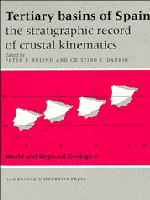Book contents
- Frontmatter
- Contents
- List of contributors
- Preface
- Dedication to Professor Oriol Riba IArderiu
- Memorial, Etienne Moissenet 1941–1994
- PART G GENERAL
- PART E EAST
- PART W WEST
- PART C CENTRE
- C1 Structure and Tertiary evolution of the Madrid basin
- C2 Neogene tectono-sedimentary review of the Madrid basin
- C3 Sedimentary evolution of lake systems through the Miocene of the Madrid Basin: paleoclimatic and paleohydrological constraints
- C4 Paleomorphologic features of an intra-Vallesian paleokarst, Tertiary Madrid Basin: significance of paleokarstic surfaces in continental basin analysis
- C5 Tectono-sedimentary analysis of the Loranca Basin (Upper Oligocene–Miocene, Central Spain): a ‘non-sequenced’ foreland basin
- C6 Paleoecology and paleoclimatology of micromammal faunas from Upper Oligocene – Lower Miocene sediments in the Loranca Basin, Province of Cuenca, Spain
- C7 Fluvial fans of the Loranca Basin, Late Oligocene – Early Miocene, central Spain
- C8 Saline deposits associated with fluvial fans, Late Oligocene – Early Miocene, Loranca Basin, Central Spain
- C9 Shallow carbonate lacustrine depositional controls during the Late Oligocene – Early Miocene in the Loranca Basin (Cuenca Province, central Spain)
- PART S SOUTH
- Index
C8 - Saline deposits associated with fluvial fans, Late Oligocene – Early Miocene, Loranca Basin, Central Spain
Published online by Cambridge University Press: 04 August 2010
- Frontmatter
- Contents
- List of contributors
- Preface
- Dedication to Professor Oriol Riba IArderiu
- Memorial, Etienne Moissenet 1941–1994
- PART G GENERAL
- PART E EAST
- PART W WEST
- PART C CENTRE
- C1 Structure and Tertiary evolution of the Madrid basin
- C2 Neogene tectono-sedimentary review of the Madrid basin
- C3 Sedimentary evolution of lake systems through the Miocene of the Madrid Basin: paleoclimatic and paleohydrological constraints
- C4 Paleomorphologic features of an intra-Vallesian paleokarst, Tertiary Madrid Basin: significance of paleokarstic surfaces in continental basin analysis
- C5 Tectono-sedimentary analysis of the Loranca Basin (Upper Oligocene–Miocene, Central Spain): a ‘non-sequenced’ foreland basin
- C6 Paleoecology and paleoclimatology of micromammal faunas from Upper Oligocene – Lower Miocene sediments in the Loranca Basin, Province of Cuenca, Spain
- C7 Fluvial fans of the Loranca Basin, Late Oligocene – Early Miocene, central Spain
- C8 Saline deposits associated with fluvial fans, Late Oligocene – Early Miocene, Loranca Basin, Central Spain
- C9 Shallow carbonate lacustrine depositional controls during the Late Oligocene – Early Miocene in the Loranca Basin (Cuenca Province, central Spain)
- PART S SOUTH
- Index
Summary
Abstract
During sedimentation of stage 2 of the ‘Upper Unit’, four saline units developed in the central part of the Loranca Basin. These deposits occur associated with the palaeogeographic limits of the Tortola and Villalba de la Sierra fluvial fans. Analysis of facies, sequences and their distribution through time permit examination of the evolution of saline environments during fan evolution. Saline facies distribution is asymmetric and controlled by fan activity. Primary gypsum is the dominant lithology of the saline deposits. The absence of anhydrite or more-soluble minerals reflects low salinity of the brines. Triassic and Cretaceous gypsiferous source rocks, basin configuration, and progressive aridity were the controls on the development of these saline environments.
Introduction
The Loranca Basin is located in the central part of Spain and it was filled by continental deposits from Late Oligocene to Miocene (Turolian) times. During ‘Upper Unit’ deposition, from Late Oligocene to Early Miocene (Agenian), three different ‘stages’ can be distinguished in the evolution of the Tórtola and Villalba de la Sierra depositional systems (Diaz Molina et al., 1989; see also Chapters C5 and C7). The first stage corresponds to the most active time interval of the Tortola and Villalba de la Sierra humid fans, when the Loranca Basin was connected to the Madrid Basin. During the following stage, syn-sedimentary folding started to plug the area connecting the Loranca Basin with the Madrid Basin, and local base levels were being established with development of wet areas of around 600 km2 (Fig. 1).
- Type
- Chapter
- Information
- Tertiary Basins of SpainThe Stratigraphic Record of Crustal Kinematics, pp. 308 - 312Publisher: Cambridge University PressPrint publication year: 1996
- 1
- Cited by



